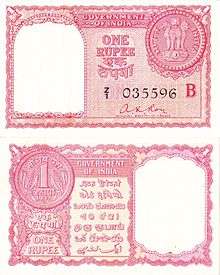Gulf rupee

The Gulf rupee (Arabic: روبيه or روبيه خليجيه), also known as the Persian Gulf rupee, was a currency used in the countries of the Persian Gulf and the Arabian Peninsula between 1959 and 1966. It was issued by the Government of India and the Reserve Bank of India and was equivalent to the Indian rupee.
History
In the beginning to the middle of the 20th century, the Indian rupee was extensively used as currency in the countries of the Gulf and Arabian Peninsula. To reduce the strain put on India's foreign reserves by gold smuggling caused by this external use of the rupee, a separate currency was created. The Gulf rupee was introduced by the Indian government in 1959 as a replacement for the Indian rupee, for circulation exclusively outside the country.[1] At the time, the Indian rupee was pegged to the British pound at a rate of 13⅓ rupees = 1 pound.
Two states, Kuwait and Bahrain, replaced the Gulf rupee with their own currencies (the Kuwaiti dinar and the Bahraini dinar) after gaining independence from Britain in 1961 and 1965, respectively. However, even today, in Bahrain 100 fils (one tenth of a Bahraini dinar) are referred to in Arabic as a "rupee" or "rubiya" (Arabic: ربية) in common parlance.
On 6 June 1966, India devalued the rupee. To avoid following this devaluation, several of the states using the rupee adopted their own currencies. Qatar and most of the Trucial States adopted the Qatar and Dubai riyal, while Abu Dhabi adopted the Bahraini dinar. Only Oman continued to use the Gulf rupee, until 1970, with the government backing the currency at its old peg to the pound. Oman replaced the Gulf rupee with its own rial in 1970.
Banknotes
Notes were issued in denominations of 1 rupee by the Indian government and 5, 10 and 100 rupees by the Reserve Bank of India. The notes were in designs very similar to the standard Indian notes but were printed in different colours. While the 1 rupee and 10 rupee notes were printed in red, the 5 rupee notes were printed in orange and the 100 rupee notes were printed in green. The serial numbers of the banknotes issued in all denominations were prefixed by a Z.
References
- ↑ Reserve Bank of India (Amendment) Act, 1 May 1959
External links
style="height:40px"| Preceded by: Indian rupee Reason: creation of new currency for use outside of India Ratio: at par |
Currency of Kuwait 1959 – 1961 |
Succeeded by: Kuwaiti dinar Ratio: 1 dinar = 13 1⁄3 rupees = 1 British pound |
| Currency of Bahrain 1959 – 1965 |
Succeeded by: Bahraini dinar Ratio: 1 dinar = 10 rupees = 0.75 British pound | |
| Currency of Qatar 1959 – 1966 |
Succeeded by: Saudi riyal Location: Qatar and Trucial States except Abu Dhabi Reason: devaluation of the Gulf rupee before delivery of replacement Ratio: 1 riyal = 1.065 rupee | |
| Currency of Trucial States 1959 – 1966 | ||
| Succeeded by: Bahraini dinar Location: Abu Dhabi Reason: devaluation of the Gulf rupee before delivery of replacement Ratio: 1 dinar = 10 rupees = 0.75 British pound | ||
| Currency of Muscat and Oman 1959 – 1970 Concurrent with: Maria Theresa thaler, Bahraini dinar, Kuwaiti dinar, Dhofar baiza, Muscat baiza, and Oman baiza Note: the Gulf rupee circulated primarily near the coast (Muscat) |
Succeeded by: Omani rial Ratio: 1 rial = 13 1⁄3 rupees = 1 British pound |